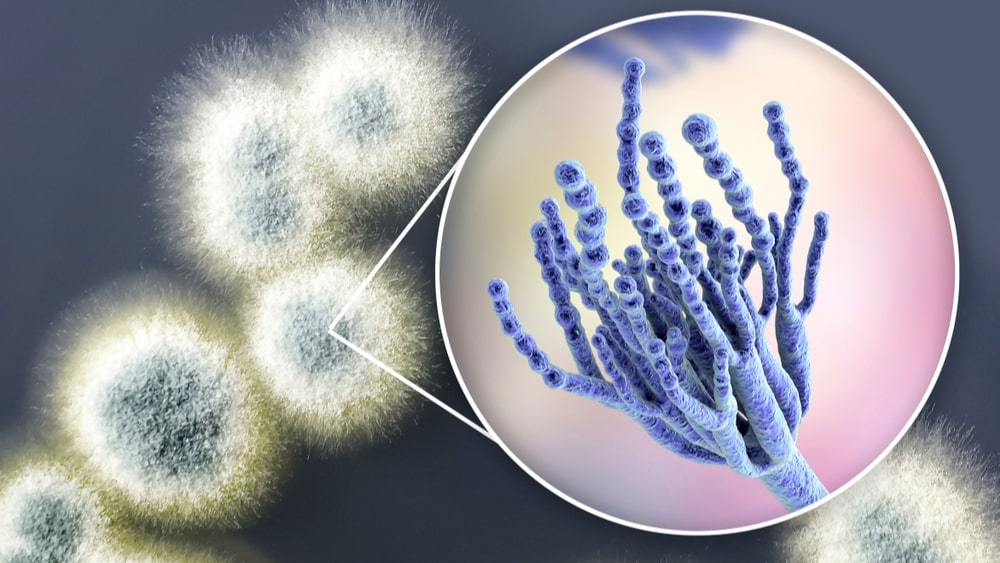Fungi are widely distributed organisms on earth. The study of fungi is known as mycology. They have great environmental and medical importance like penicillium as an antibiotic but some fungi cause diseases in plants and animals (like wheat rust causes Puccinia). Many fungi are free-living in soil and water. Some other fungi form parasitic or symbiotic relationships with plants or animals because they lack chlorophyll. They are eukaryotic organisms. They can grow anywhere but preferably grow in warm and humid places. Their cells contain membrane-bound organelles and well-defined clear nuclei. They are unicellular as well as multicellular. They reproduce by both sexual and asexual methods. Many fungi are harmful; they cause infections of plants known as rots, rusts, blights, wilts, and smuts.
Examples: Yeasts (Unicellular), Molds (Multicellular), Mushrooms (Multicellular), etc.
Importance of Fungi:
- They are decomposers and recyclers of nutrients.
- Plants live in a symbiotic relationship with mycorrhizae fungi.
- Yeasts are used to make beer and bread.
- They produce penicillin antibiotics.
- Mushroom fungi are eaten as food.
- Aspergillus is used to make soy sauce.
- Yeasts ferment sugar to produce alcohol.
- Trichoderma is used to produce cellulose which is used to make fruit juice.
- Genetically, engineered yeast strains are used to make proteins (Hepatitis B vaccine).
Table of Contents
Morphology of Fungi
Fungi are divided into two morphological forms viz. yeasts and hyphae (mold). Yeasts are unicellular nucleated and rounded fungi which reproduce asexually by budding formation (blastocondia) or fission. Hyphae are multi-cellular and filamentous fungi that reproduce asexually or sexually. Dimorphism is another condition whereby a fungus can exhibit either the yeast form or the hyphal form, depending on growth conditions.
Generally, Yeast cells are 1-5 micrometers in width and 5-30 micrometers in length which are a larger size than bacteria. Commonly they are oval or egg-shaped but sometimes they are elongated and spherical. Yeast cells do not have flagella (Fig. 1.1).
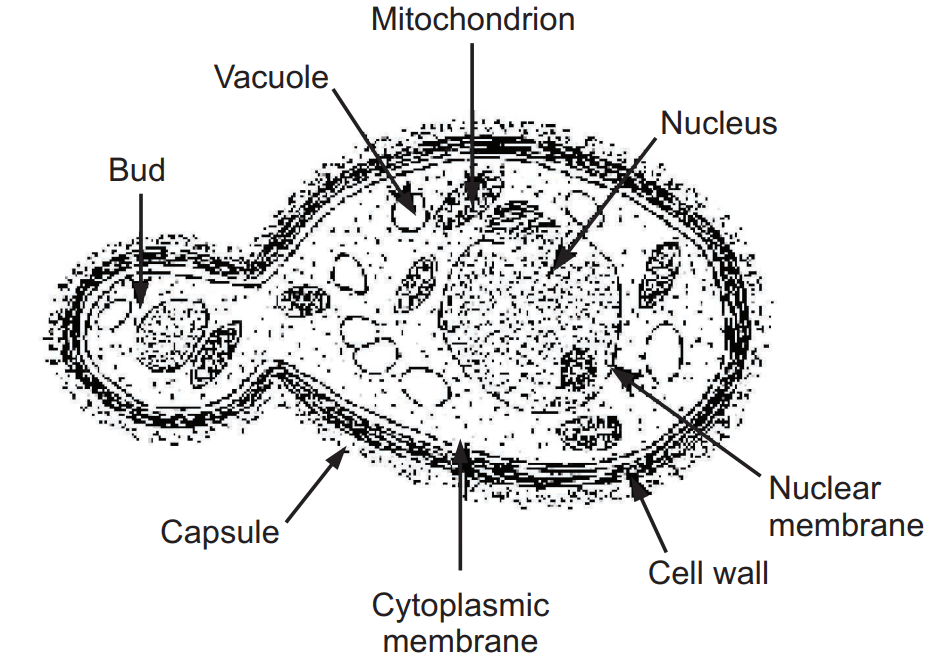
They have granular cytoplasm enclosed with a cell wall which contains reserved materials like oil globules, glycogen, and volutin but the content of glycogen accumulation is increased with the decrease in fermentation. They have large nuclear vacuoles with prominent nuclei and nucleolus. The cell wall is composed of chitin (1-10%) along with protein, lipid, mannan (15-23%), and glucan (50-60%). Glucan is the main structural component of the cell wall which is the branched polymer of glucose i.e. beta 1, 6-glucan, beta 1, 3-glucan, and beta 1, 3-beta 1, 6-complexed with chitin. Glucan and chitin are the important components that regulate cell division as well as provide rigidity to the cell wall. The mode of nutrition of fungi is organotypic and heterotrophs and mostly are saprophytic and some are parasitic. They grow best in an acidic environment. They can tolerate high sugar concentrations and dry conditions. Most of the fungi are obligate aerobes (molds) and few are facultative anaerobes (yeasts). The optimum temperature of growth for most saprophytic fungi is 20-30°C while parasitic fungi grow at 30-37°C.
Mold is a type of fungus which has two parts mycelium and spores. Mycelium is made up of several filaments known as hyphae. The hypha is generated from spores. Each hypha is about 5-10 micrometer wide. Hyphae are composed of another tuber wall surrounded by a cavity known as a lumen. This lumen is filled with protoplasm. Between the protoplasm and wall, there is a plasmalemma. Hyphae are of three types.
- In some molds like coenocytic fungi, the cytoplasm passes through and among cells of the hypha uninterrupted by the cross wall which is known as non-septate fungi.
- Septate with unicellular cells and
- Septate with multicellular cells which contain more than one nucleus (Figs. 1.2 and 1.3).
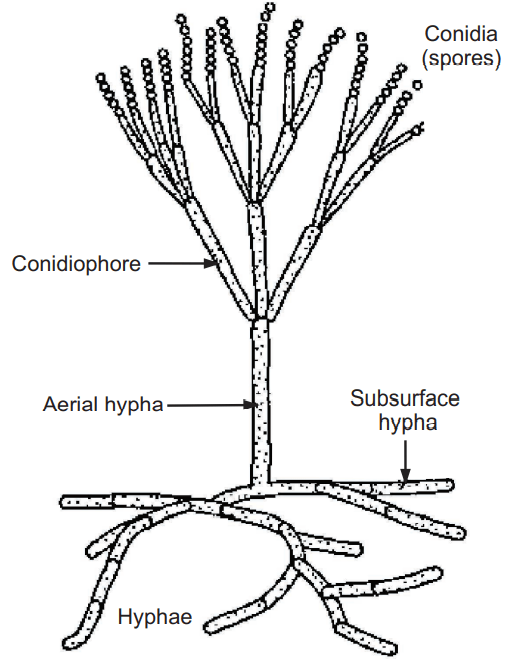
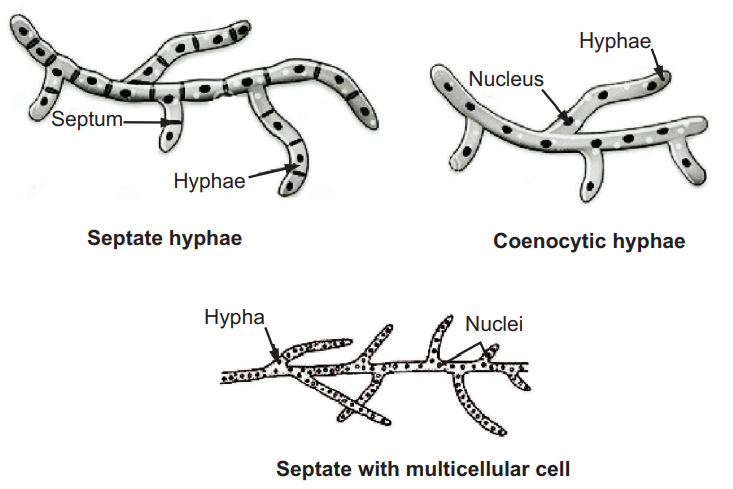
Dimorphic Fungi: Dimorphic fungi are fungi that can exist in the form of both mold and yeast. Dimorphic fungi are fungi that can reproduce as either a mycelial or a yeast-like state. Generally, the mycelial saprotrophic form grows at 25°C, and the yeast-like pathogenic form at 37°C.
Dimorphism is important in the identification of mycoses. These fungal pathogens generally overcome the physiological and cellular defenses of the normal human host by changing their morphological form. An example: is Penicillium marneffei, a human pathogen that grows as a mold at room temperature, and as yeast at human body temperature.
Some diseases caused by dimorphic fungi are blastomycosis, histoplasmosis, sporotrichosis, etc. Candida albicans cause oral and genital infections.
Classification of Fungi
True fungi are classified into two major classes viz. Lower true fungi and higher true fungi
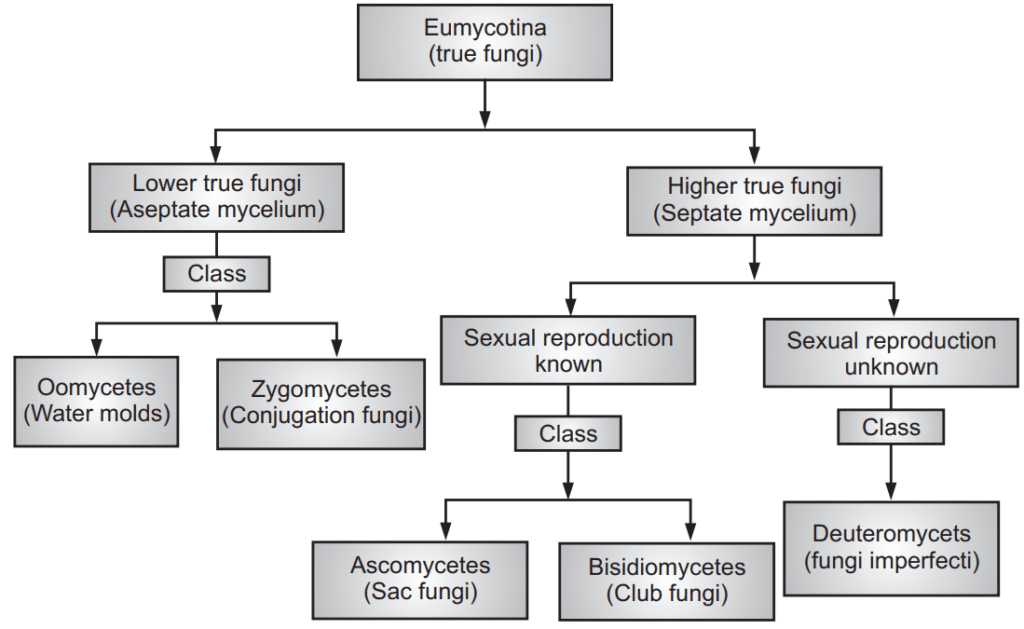
Lower True Fungi:
They are also known as water fungi. They have aseptate mycelium. Based on the category they are of two types: Oomycetes and Zygomycetes.
Oomycetes are eukaryotic cells and pathogenic in nature and hence they are having disreputable properties. They have a well-defined cell wall, composed of β-1,3, and β-1,6 glucans, and the body is composed of mycelium formed by hyphal networks. They absorb nutrition by heterotrophic mode. They cannot do photosynthesis due to a lack of chlorophyll and hence they are parasitic. They undergo sexual reproduction and produce spores as a mode of reproduction. They cause seedling blights, damping-off (Pythium Orphanides-matum and P. ultimum), root rots (Phytophthora cinnamomi), foliar blights and downy mildews (Plasmopara viticola) diseases.
Saprolegnia is the only genus of oomycete pathogens that do not contain plant pathogens but contain pathogens of different water-borne organisms such as crayfish.
Zygomycetes:
They are conjugated fungi made up of the fusion of the protoplasts of two equal or unequal gametangia. They are having mainly three parasitic orders viz. Mucorales, Entomophthorales, and Zoopagales. They reproduce by both sexual and asexual methods. They have sexual spores which are known as Zygospores whereas asexual reproduction occurs by sporangiospores. Zygospore germinates to produce a hypha and the hyphae are generally separated. The hypha wall is composed of chitin chitosan. Example: Black bread mold (Rhizopus stolonifer), Mucor, Basidiobolus, Conidiobolus.
Higher Fungi:
They have septate mycelium. The septa have each a central pore and no motile cells are produced in the life cycle. They have three classes viz. Ascomycetes, Basidiomycetes and Deuteromycetes.
Ascomycetes:
- Sexual spores are produced within a sac-like structure called an ascus.
- Sexual spores are called ascospores.
- Asexual reproduction occurs by single-celled or multi-celled conidia.
- Ascomycetes are also known as sac mycetes.
- Hyphae are generally septated.
- Examples: Saccharomyces, Arthroderma, Gibberella.
Basidiomycetes:
- Sexual spores are produced externally on a basidium.
- Sexual spores are known as basidiospores.
- Asexual reproduction occurs by budding, fragmentation, or conidia formation.
- They are commonly called mushroom groups.
- Hyphae are generally septated.
- Examples: Amanita, Agaricus, Filobasidiella.
Deuteromycetes:
- No sexual stage is present.
- Deuteromycetes are also known as fungi imperfection.
- Asexual reproduction occurs by means of conidia.
- Most of the human and animal pathogens are present in this class.
- Examples: Candida, Cryptococcus, Trichophyton, Epidermophyton, Histoplasma.
Cultivation of Fungi
Most fungi grow more slowly than bacteria. They grow on the usual bacteriological culture
media at a temperature of 20-30°C. High sugar content in acidic media (pH 5.6) is tolerant to molds. Generally, glucose and peptones content media is useful for the isolation of molds and some yeast. Some other well-known media such as solid Sabouraud agar media is used for the culture of fungi that contain maltose and peptone with less agar content. Media is acidic with pH 5.5 which inhibits bacterial growth. Potato Dextrose agar, brain heart infusion, and Czapekdox agar media are also used for the isolation of fungi. Yeast grows in colonies whereas filamentous fungi grow as a mycelium. Yeast forms colony: Example: yeast, Cryptococcus neoformans. Yeast-like colony: Example: Candida albicans. Hyphomycete form colony: Example: Dermatophytes. Saprophytic fungi can grow in the media containing chloramphenicol and cycloheximide. Papanicolaou stain is good for the initial differentiation of dimorphic fungi. Most of the fungi are gram-positive but Nocardia and actinomyces are gram variable.
Reproduction of Fungi
The fungi have three main types of reproduction viz. vegetative, sexual and asexual type. Some fungi show only one known reproduction type. Asexual forms (anamorph) were often described separately and given different names than the sexual form (teleomorph). The complete form having both reproductive forms is called a holomorph (Flowchart 2 and Fig. 1.4).
Vegetative method:
In this type of reproduction, the new individual is formed from the somatic portion of the fungal thallus without seed production. There are some methods by which this propagation method is carried out viz. Fragmentation, fission, budding, rhizomorphs, and sclerotia.
- Fragmentation: In this process, the mycelium breaks into similar fragments with the help of external force and gradually turns into a new mycelium.
- Fission: In the case of unicellular fungi, the single cell is multiplied by this method. The parent cell is divided into two daughter cells by division of nucleus followed by division of cytoplasm and cell wall formation.
- Budding: Sometimes the parent cells produce the outer growth known as buds. These buds are generally enlarged and slowly separated out from the parent cells by a cross wall and finally, a new yeast cell is formed.
- Rhizomorphs: In some higher fungi, hyphae are interwoven to form a rope-like structure known as rhizomorphs. Under favorable conditions, they grow and form fruiting bodies.
- Sclerotia: It occurs in ergot plants where hyphae become interwoven to form a compact mass surrounded by the hard coat. This structure is known as sclerotia. Under favorable conditions, these sclerotia germinate and form new mycelia.
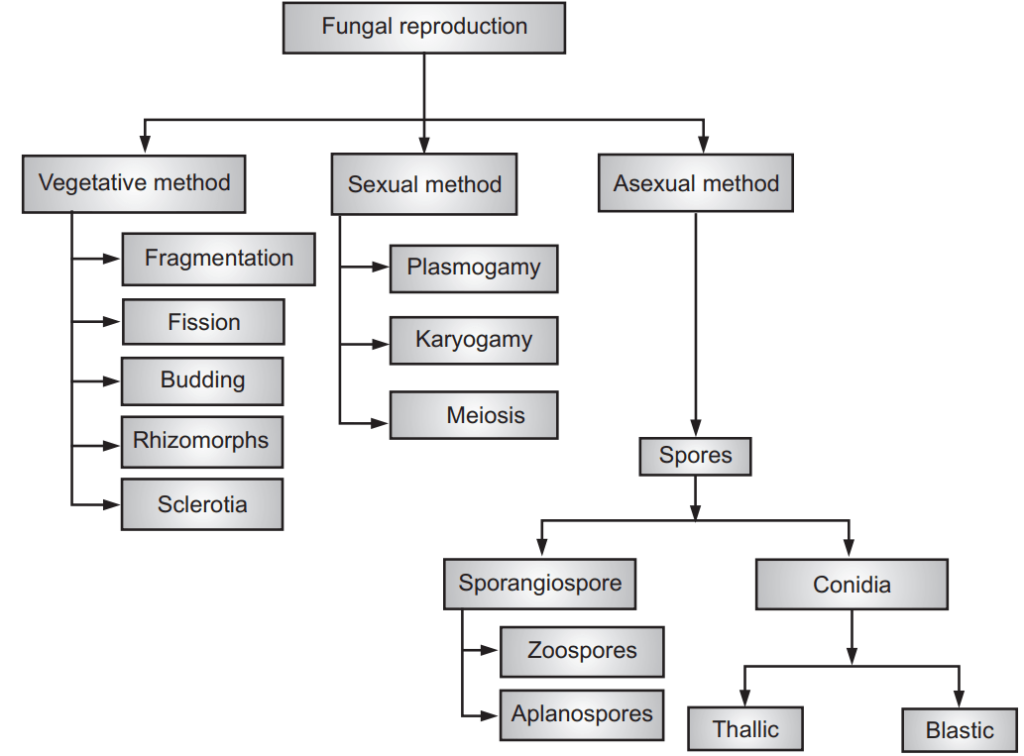
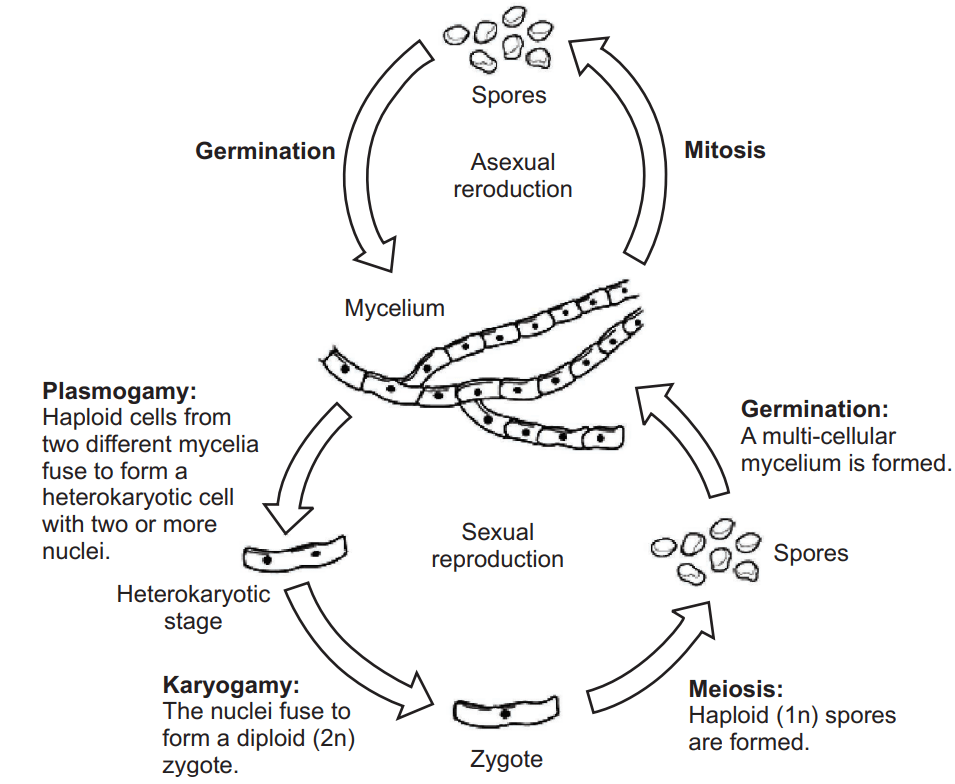
Asexual reproduction:
This method is carried out by sporulation where new spores are formed in reproductive cells by the mitosis process. Each spore develops into a new mycelium. Usually, spores are unicellular. There are different types of spores that form in various fungi.
- Zoospores: They are flagellated motile spores produced inside a structure known as zoosporangia. They do not have a cell wall and are produced in the lower fungi. Examples: Achyla and Saprolegnia (Fig. 1.5).
- Sporangiospores: They produce inside the sac-like structure known as sporangium. They are non-motile and branched. They can disperse by the wind. Examples: Rhizopus and Mucor.
- Chlamydospores: They develop thick walls from hyphal cells. They store reserved foods and with the favorable condition, they develop into a new mycelium. Examples: Mucor, and Fusarium.
- Oidia: In some filamentous fungi, the hyphae break up into the individual cell, known as oidia. They are oval-shaped and do not store reserved food. Example: Rhizopus.
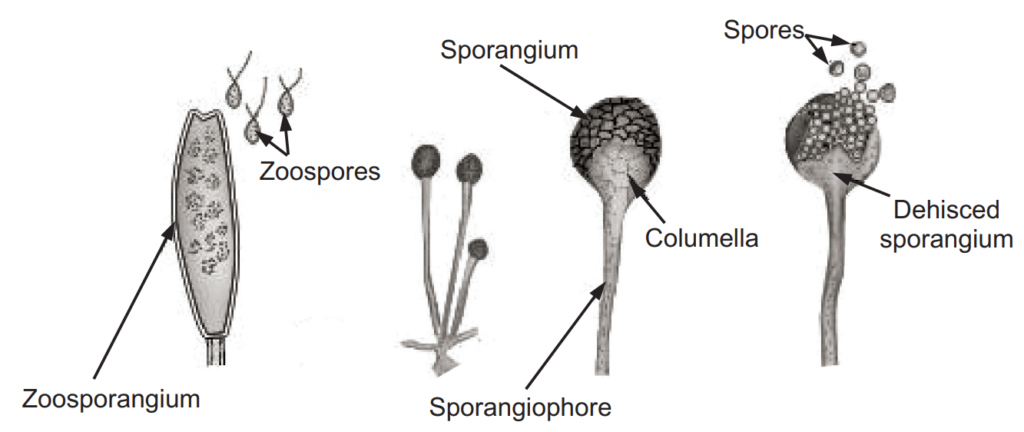
Fungi produce two types of asexual spores viz. sporangiospores and conidia. Sporangiospores are formed inside the sporangium. They are of two types viz. motile and non-motile spores. Motile spores are known as Zoospores and non-motile spores are known as Aplanospores. Zoospores are three types namely Chytridiomycota, Hypochytridiomycota, and Oomycota.
Conidia are formed at the tip of supporting hyphae known as conidiophores. They are mainly of two types namely Thallic conidia and Blastic conidia. Thallic conidia develop by septation and fragmentation of a hypha. They are of two types Arthrospores (formed by septation and fragmentation of existing hyphae) and Chlamydospores (resting spores). Blastic conidia develop by the budding method. They develop as single spores and are classified as Blastospores (formed by budding of hyphae), Porospores (developed through the distinct pores in the hyphal wall), Aleuriospores (single and terminal spores), Annellospores (a chain spores), Phialospores (pushed up from the tip of the conidiophore).
Sexual Reproduction:
Sexual reproduction occurs via the fusion of gametes and gametangia, seen in all groups of fungi. This is the method where fusion occurs between two compatible sex cells or gametes of opposite strains. Fungal sex organs are known as gametangia. The reproduction occurs in three phases namely Plasmogamy, Karyogamy, and Meiosis.
- Plasmogamy: It is the accumulation of protoplast cells of reproductive hyphae. The nucleus from one male and another female are closed together as a pair without fusion. These types of cells are known as dikaryon. This phase has several methods like Planogametic copulation where motile gametes undergo fusion; Gametangial contact where gametangia come closer to each other and form a fertilization tube, Gametangial copulation where gametangia fuse together and form zygospore, Spermatization where spermatia are formed externally on special hyphae and spermatia are developing inside the cavities known as spermatogonia and finally Somatogamy where the fusion between two somatic cells has occurred.
- Karyogamy: This is the step where two-parent nuclei are fused together. The fusion occurs very fast in lower fungi whereas delayed in higher fungi so that hyphae remain dikaryotic. This phase is known as the diary phase.
- Meiosis: After the diary phase, the next step is meiosis where after cell division, produce four daughter cells each with half the number of chromosomes of the parent cell, as in the production of gametes and plant spores. The production of meiotic spores is known as meiospores.
Make sure you also check our other amazing Article on : Gaseous Sterilization
